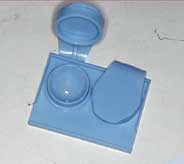Case study: Accidental corneal transplant dehiscence
Physicians discuss how to prevent infection when the anterior segment is open and the cornea is contaminated.

Eric D. Donnenfeld, MD: This is one of my favorite cases. Dr. Henry Perry had removed sutures from a corneal transplant patient and asked the patient to come back the next day. There was a little suture sticking up, and he wanted to cauterize it with the argon laser, which was down that day.
 Eric D. Donnenfeld |
The patient came in the next day and a fellow said, “I’m going to try to take that suture out.” And he took a large pair of pliers, grabbed the suture and ripped. Then, I hear this screech: “Dr. Donnenfeld, come quickly!” I walked into the room, and my fellow was sitting there holding the cornea in his hand. The patient was sitting there with no cornea on the eye, just an open anterior segment after corneal transplantation. And the fellow said, “What are we going to do, Dr. Donnenfeld?” And I said, “Well, the first thing we’re going to do is we’re going to take pictures of this.” So we took the pictures, put the contact lens in a case, took the patient into a back room and sewed the cornea back on. The patient actually did well.
|
|
The question here is, what do you do for antibiotic prophylaxis for this patient? How do you manage this patient who had an open anterior segment for about 15 minutes and a contaminated cornea that is being put back on the eye? What do you do for prophylaxis to prevent infection?
William B. Trattler, MD: Clearly, you want to use a fourth-generation fluoroquinolone. I think having benzalkonium chloride (BAK) in the medication may be helpful as well. The BAK is a broad-spectrum antiseptic with rapid antimicrobial effects that helps to kill all varieties of organisms, from fungi to bacteria. This medication should be used frequently for 7 to 10 days afterward, maybe every 3 or 4 hours.
 Kerry D. Solomon |
Dr. Donnenfeld: This is a case where I used some intracameral antibiotic. In addition, I would use a topical fourth-generation fluoroquinolone with BAK for the reasons Dr. Trattler has described. Finally, I would put Betadine (povidone-iodine 5%, Purdue Frederick) prep on after I had closed the cornea. Certainly, you do not want to use Betadine until the cornea is closed.
Kerry D. Solomon, MD: I had a case not quite like this, but pretty similar. Recently, a woman who came in dehiscenced 359°. Her eye was wide open, with her graft hanging on her lid for about 5 hours before she could get down to see us. And you know it is not that common that they get infected, but I do not know why. But when we see dehiscence, which we see and fix a lot in South Carolina, I am amazed that they do not get infected more than they do.
|
|
Images: Ophthalmic Consultants of Long Island |
For more information:
- Eric D. Donnenfeld, MD, can be reached at Ryan Medical Arts Building, 2000 North Village Ave., Rockville Centre, NY 11570; 516-766-2519; fax: 516-766-3714. Dr. Donnenfeld is a consultant for Alcon and Allergan and performs research for Ista Pharmaceuticals.
- Kerry D. Solomon, MD, can be reached at the Storm Eye Institute, 167 Ashley Ave., Room 221, PO Box 250676, Charleston, SC 29425; 843-792-8854; fax: 843-792-6347. Ocular Surgery News could not confirm whether Dr. Solomon has a direct financial interest in the products mentioned in this article or if he is a paid consultant for any companies mentioned.
- William B. Trattler, MD, can be reached at 8940 N. Kendall Drive, #400, Miami, FL 33176; 305-598-2020; fax: 305-274-0426. He has received funding for research, consulting and/or lectures from Allergan, Inspire and Ista.



